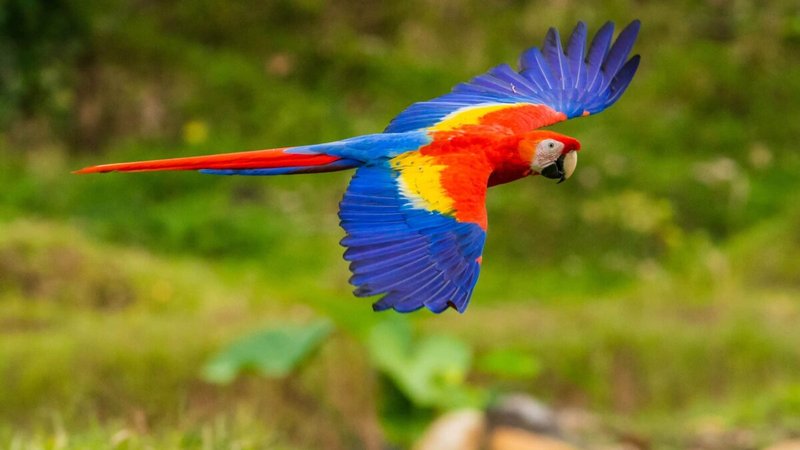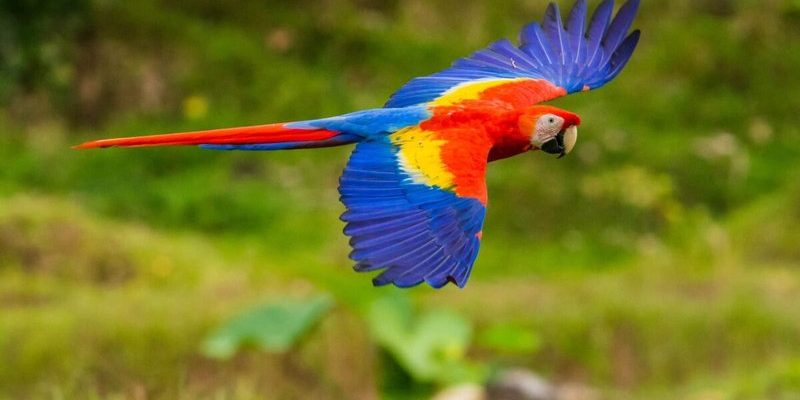
Imagine sitting in a rainforest, sipping coffee, and suddenly hearing a loud, raucous call echoing through the trees. That’s the scarlet macaw, showcasing its powerful voice. These birds don’t just look impressive; they’re also known for their intelligence and social behavior. If you’re curious about what makes them tick, you’re in for a treat! Let’s dive into the top 10 interesting facts about the scarlet macaw that will leave you amazed.
1. Stunning Appearance
Scarlet macaws are a visual marvel. Their feathers are a dazzling mix of red, yellow, and blue, which helps them stand out in their tropical habitats. The bright red body is complemented by blue wings and a yellow stripe that stretches across their back. It’s almost like nature decided to throw a party and invited the scarlet macaw to show up in its best attire!
These birds can grow to be about 33 inches long, making them one of the largest parrot species. Their size isn’t just for show, though. Those big beaks and strong claws are perfect for climbing and cracking open tough nuts and seeds, which make up a large part of their diet. Imagine trying to snack on a walnut without your hands—these birds have the tools they need to feast!
2. Native Habitat
Scarlet macaws are native to Central and South America, thriving primarily in tropical rainforests. They prefer areas with plenty of fruit-bearing trees, which provide food and nesting sites. Think of them as the social butterflies of the avian world, flitting from tree to tree in search of companionship and food.
Unfortunately, habitat loss is a big issue for these beautiful birds. Deforestation and agriculture are reducing their homes at an alarming rate. Without action to protect these environments, their populations could continue to decline. It’s a stark reminder of the importance of conservation efforts.
3. Social Creatures
Scarlet macaws are incredibly social animals. They often live in monogamous pairs or small flocks that help them find food and stay safe from predators. You might be wondering how they communicate with each other—well, it’s a noisy affair! Their loud calls can travel long distances, which is essential for keeping in touch with their mates and flock members, especially in dense forests.
This social nature also means they can form strong bonds with their partners. Just like humans, they engage in mutual grooming and playful behaviors, which help reinforce partnerships. Watching them interact is a delightful experience and showcases their deep social instincts.
4. Diet and Eating Habits
Scarlet macaws have a varied diet, primarily consisting of fruits, nuts, seeds, and sometimes insects. Their strong beaks are designed to crack open hard shells and access the tasty treats inside. It’s like having a built-in can opener! They also enjoy figs and palm fruits, which are abundant in their rainforest homes.
One interesting tidbit is that they often consume clay found along riverbanks. This might seem strange, but the clay helps them detoxify some of the toxic substances found in their diet. It’s a bit like having a natural remedy right at their fingertips.
5. Intelligence and Problem-Solving Skills
You might be surprised to learn that scarlet macaws are one of the smartest bird species around. They can solve complex puzzles and learn tricks with ease, which is why they make popular pets. In the wild, their intelligence helps them navigate their environment and find food sources efficiently.
Their problem-solving skills don’t just stop with foraging. Scarlet macaws can use tools to help them in various tasks, such as cracking nuts or manipulating objects. This level of intelligence is a big part of what makes them so fascinating to study and observe!
6. Lifespan and Longevity
Scarlet macaws enjoy a impressively long lifespan, often living 40 to 60 years in the wild, and even longer in captivity. This longevity makes them a major commitment for anyone looking to keep one as a pet. Imagine having a feathered friend for several decades—it’s like having a lifelong companion!
Their extended lifespan is partly due to their diet, social nature, and adaptability to their environments. However, with longer life comes responsibility. It’s essential for pet owners to provide a stimulating environment, proper nutrition, and regular veterinary care to keep their macaw healthy and happy.
7. Conservation Status
While scarlet macaws are stunning creatures, their populations are declining. They are currently classified as “Least Concern” by the International Union for Conservation of Nature (IUCN), but that doesn’t mean they’re out of danger. Habitat destruction and illegal pet trade have severely impacted their numbers.
Conservation efforts are underway to protect their habitats and educate the public about the importance of these birds in their ecosystems. Supporting organizations that focus on wildlife conservation can help ensure that future generations can enjoy the beauty of scarlet macaws.
8. Behavior and Vocalizations
Scarlet macaws are known for their loud and varied vocalizations. They can mimic other sounds and even human voices, which makes them popular in homes. Their calls range from shrill screeches to low, booming sounds that echo through the forest.
This vocal variety isn’t just for show; it serves practical purposes in their social structures. By communicating effectively, they can alert each other to danger or coordinate activities within their flocks. Picture a lively conversation among friends—this is exactly how macaws interact in the wild!
9. Nesting and Reproduction
Nesting is a critical part of a scarlet macaw’s life cycle. They typically nest in large tree cavities, which provide safety for their eggs and chicks. It usually takes around 26 to 28 days for the eggs to hatch, after which both parents take turns caring for the young.
The chicks are born helpless and rely heavily on their parents for food and protection. It’s heartwarming to think about how nurturing these vibrant birds can be. As the chicks grow, they begin to develop their vibrant plumage and learn essential survival skills.
10. Popularity as Pets
Due to their stunning looks and playful personalities, scarlet macaws are popular pets. However, potential owners should be aware of the commitment involved. These birds require a lot of attention, social interaction, and mental stimulation, much like a dog or cat.
Here’s the thing: owning a scarlet macaw is more than just having a pretty bird. You’re bringing a gentle giant into your home that relies on you for companionship and care. If you’re thinking about adoption, be sure to do your research and prepare for the long haul.
In summary, the scarlet macaw is more than just a beautiful bird. With their vibrant colors, intelligence, and complex social behaviors, they remind us of the wonders of nature. By learning about them, we can appreciate what these magnificent creatures bring to our world and the importance of protecting their habitats for future generations.

